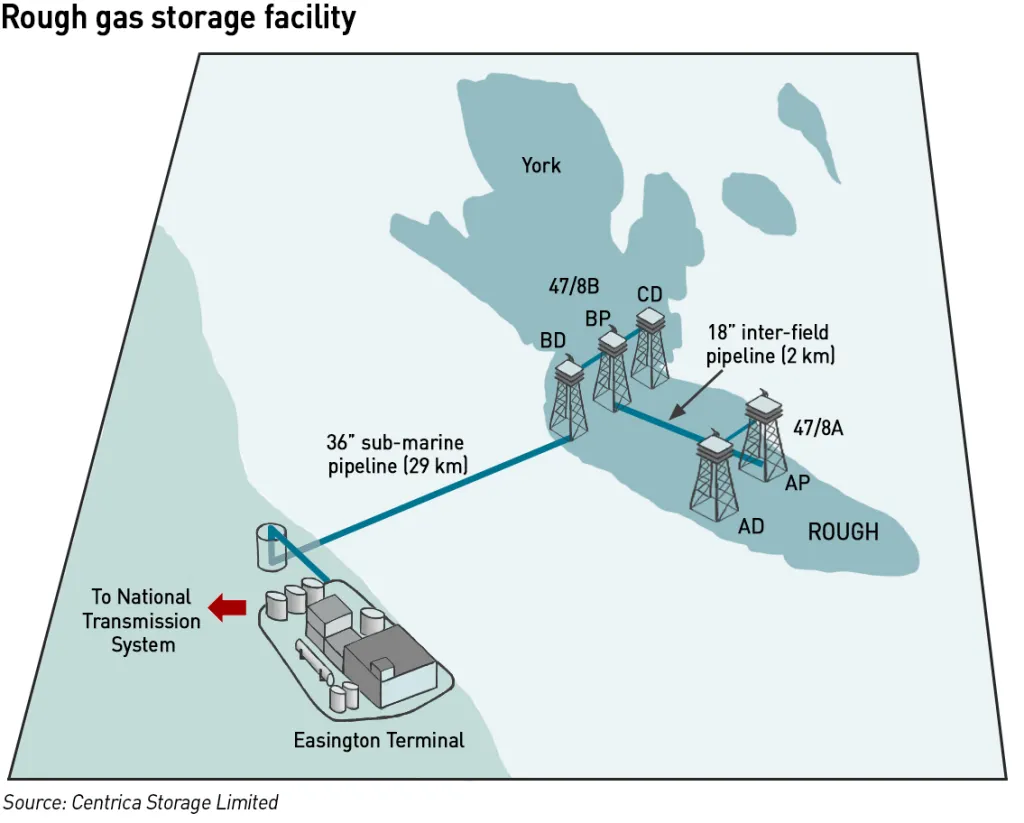Centrica and Norwegian energy giant Equinor have pledged jointly to push ahead with developing a hydrogen production hub at Easington on the Yorkshire/Humberside coast.
Currently up to one third of the UK’s total gas supply enters via Easington, much of it from Equinor’s Norwegian facilities.
The site is close to some of the world’s largest offshore wind farms. They include the 3.6GW, three-phase Dogger Bank, part-owned by Norway’s state-owned energy concern, plus Orsted’s 0.2 GW Westermost Rough farm & Eon’s 0.2GW Humber Gateway venture. The location offers huge potential for both blue and green hydrogen production.
Easington is also the landfall point – see schematic – for Centrica’s controversial Rough undersea storage caverns. Britain’s biggest gas reservoir, at one time holding up to 70% of the nation’s supplies, Rough was closed by the company in 2017 on cost grounds. Now re-licenced for operation, Rough is undergoing £ 2.2 billion of refurbishment, leading to re-opening to host badly needed reserves, prioritised by Vladimir Putin’s assault on Ukraine.
The Zero Carbon Humber partnership, intended as a hub for regional pipelines, is taking shape, bringing forward networks for producers to pump hydrogen and CO2 to the locality’s carbon-intensive industries.
With Humberside’s Saltend park of carbon-intensive industries only 16 miles distant, the area is also earmarked as a key nexus for the East Coast Cluster’s carbon capture pipeline, which would transport reclaimed CO2 to storage vaults under the seabed.
In April the government doubled its 2030 hydrogen production ambition to 10GW capacity, At least half is planned to come from electrolysed ‘green’ hydrogen.
Vårgrønna grow this H2 business
Equinor has ambitions to deliver nearly one fifth of this national target, constructing 1.8GW of hydrogen production on Humberside by 2028, starting with its flagship H2H Saltend project.
Centrica and Equinor expect that the conversion of the Easington Terminal could produce an additional 1GW of low carbon hydrogen production coupled with the around 200MW off-taker demand.
The Norwegians’ wind generation interest in the North Sea includes 40% of Dogger Bank, the world’s biggest marine park at 3.6 GW. The firm will operate all phases in collaboration with SSE Renewables and Italian-linked Norwegian investors Vårgrønn.
Centrica CEO Chris O’Shea said: “We are delighted to be working in partnership with Equinor to explore opportunities to deliver on our commitments to help the UK transition to net zero as hydrogen will play a key role in achieving this.
“Like Equinor, Centrica are committed to investing in the Humber region, levelling up and de-carbonising industry to create a world leading, green energy driven, economic hub.”
For Equinor, senior vice president for low carbon Grete Tveit responded: “The Humber is in a unique position to lead the way on industrial decarbonisation, with Equinor’s Hydrogen to Humber (H2H) projects at the forefront of this transition.
“Partnering with Centrica to potentially develop a new hydrogen hub at one of the UK’s most significant industrial sites could help to transform this region’s energy mix whilst preserving and creating jobs and skills.”




